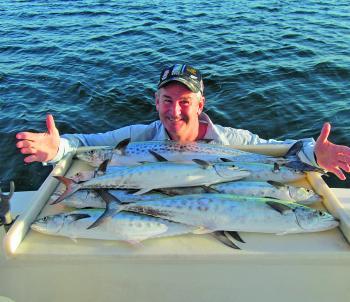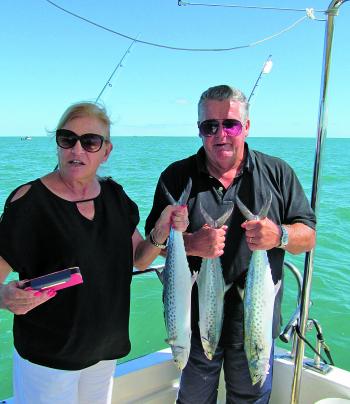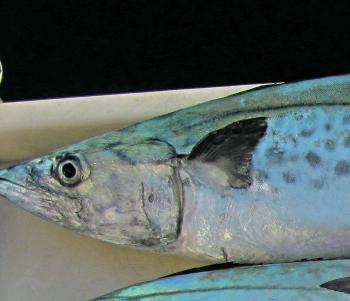Spotty mackerel fishing in Moreton Bay is probably the most fun you can have in SEQ when the weather gods are on your side. I started fishing for them 40 years ago when the only thing most of us knew was to throw a pillie at whatever was splashing on top of the water. We used 40lb+ wire trace and just waited to get hit. There weren’t too many hits, although when one did decide to grab, all hell would break loose, especially with the old 12ft fibreglass rod and Alvey reel.
As beginners in those years we knew nothing of chrome slugs, paravaning or anything else, as the only other people catching them were the ring netters that used to be in the bay. I remember the first time an old timer came up to me in his boat to help me catch a few fish. He could see me trying hard with pillies and wire trace with not much success. He had made his own lead sinker lures which worked unbelievably well. They consisted of a barrel sinker with stainless wire through the middle, a single 5/0 hook at one end and a swivel on the other end, belted flat with a hammer to look like a small baitfish. To keep it shiny he would run his knife along the lead. With all that weight he could cast it much further than I could ever throw a pilly. He gave me two of them and had the time and patience to tell a young know-it-all how to catch spotties, and from then on my fortunes changed. I will always be grateful to him, and take the time to help other people the way he helped me.
Spotties have been coming into the bay for as long as anybody can remember. The first run can be as early as October, consisting mainly of large females. Then there’s normally a quiet period for two or three weeks, before an explosion of thousands of fish. This lasts until at least February. Most years it keeps going all the way through to Easter.
We learned the best way to target these fish was to look for feeding schools, power up to them and throw chrome slugs around the schools with a fast retrieve. It sounds easy, but you have to know which feeding schools are mackerel and which ones are not. It took a little while to learn how to tell the feeding schools apart. With the help and guidance from the old pro ring netters, we figured it out. It made it so much easier to find the spotties.
The first thing to look for is the terns flying slowly above the feeding school of fish. Sometimes the terns even look like they are doing the backstroke. Why? Because mackerel don’t push schools around like tuna do. Instead, they surround the bait, bring it to the surface, and then take turns going through the bait while the others swim around like circling wagons in the old cowboy movies. The birds look like they are doing the backstroke because the mackerel keep the bait in one place, and the birds try to hover rather than fly forward.
Another way mackerel behave differently is when they stop feeding, such as when a bait ball gets smaller or a boat scares them. They don’t go far away and don’t go deep. Instead, they actually circle around to find the bait ball they were just on. If you hang around the area and actually keep an eye out, most times you will see them swimming in a large circle. Many fish get caught by anglers throwing the slugs around the area they were feeding, sometimes even without seeing the fish.
The easiest way to identify spotties, however, happens on dead calm days. Spotties swim the way ducks fly, in a triangle formation, with a single fish at the front followed by two or three and so on behind them. This is very different from the way tuna swim, which is willy-nilly in one big group, darting all over the place. That’s why you should always keep an eye out on glassy days for this formation on the surface. It’s easy to see and you’ll know they are spotties.
When you find a feeding school, the best way to catch them is with chrome slugs. There’s a huge range on the market, and the appearance comes down to personal preference. Just remember that these fish normally eat whitebait, bluebait or frogmouth pilchards, so make sure your slug is around that size – about 5-6cm. When it comes to weight, you can use anything from 25-40g. I usually use 34g. I retrofit my slugs with a single hook, as it makes it easier to unhook the fish and much easier to release them (the limit these days is only five over 60cm).
When I cast and retrieve around the feeding school, I never use wire trace or swivels. The swivel gets bitten off too many times, and I find you get many more strikes without wire. All I do is double the line, which is normally 15-18lb, as I don’t like gaffing the fish and the double line helps me lift them out of the water.
Many anglers are now using paravaning in the bay for school mackerel, and this concept also works very well for spotties, especially on the days they are not feeding aggressively on the surface. When you are travelling at 5-6 knots while you’re looking for feeding fish, and have the paravanes out, you can catch one where you least expect it.
Another thing I learned was that once you find the fish in a certain part of the bay, they tend to be there for a while until big winds and bad weather move them on (most likely they can’t find the bait). Also, the water temperature needs to be above 24°C. That’s why most of the ring netters didn’t go out until after 10am; the best time to catch them was around lunchtime when the water was very warm.
And remember that those frames are very nice on the BBQ. The flesh is moist and delicious, and comes away easily from the bones. Everyone is sceptical at first, but when they try it, they love it!
Now that you have the information you need to target these great tablefish, I hope you’ll get out there soon and give it a go!
Reads: 4680
A lovely mixed bag of spotted and school mackerel.

You have to match the hatch to get the best results.

It’s not hard to catch a good feed of spotties once you know how.

Spotties have small spots concentrated in a band along the fish’s length. School mackerel have fewer, larger, haphazard spots, which extend further down the fish’s belly.




